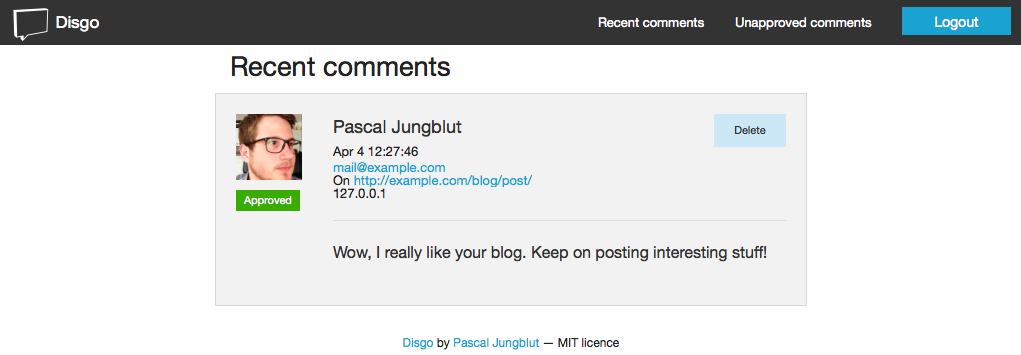Disgo is a simple commenting system for the web, written in Go. It is inspired by Disqus but does not come with all the bells and whistles. Some (anti-)features are:
- Ajax-based: no Iframes
- no Javascript dependency, especially not jQuery
- works on all modern browsers and Internet Explorer >=10
- supports MySQL and PostgreSQL
- customizable CSS (in fact, there is currently no default client CSS)
Optional:
- admin approval of new comments
- e-mail notification of new comment
- IP address-based rate limiting
- markdown support
- Disqus import
Here's what the admin interface looks like:
You can download a ready-to-go release for most common platforms (FreeBSD, Linux, OS X, Windows). Just unpack and configure it.
You need to have the Go environment installed. To build and install disgo, simply run:
$ go get github.com/pascalj/disgo
$ go install github.com/pascalj/disgo
You can build a release with
$ make release
build/ then contains all you need: binaries for the most common platforms, the public files, templates and a sample of the configuration file.
The various switches in the configuration sample file are documented. To get started, just copy the disgo.gcfg.sample to disgo.gcfg (yes, it's .gcfg and not .cfg) and edit it to your needs.
Two things are mandatory:
A database must be configured, either MySQL or PostgreSQL and you need to set at least one origin. An origin is a URL where you want to allow comments. You can tell disgo to load a specific config by providing the -config command line parameter. It is strongly suggested to change the secret.
The server will listen on 0.0.0.0:3000. You can change that by setting the HOST and/or PORT environment variable.
Fire up the server process:
$ disgo
After that, the admin interface will be available at the host and port you configured (e.g. http://example.com:3000). The first time you access the admin panel you're asked to create an admin user.
Once you got everything up and running, it's easy to embedd comments in your website. Just add the following script to your website, just before the closing </body> tag:
<script>
var disgo = {
base: 'http://example.com:3000'
}
document.write('<script src="' + disgo.base + '/js/disgo.js">\x3C/script>')
</script>Replace example.com:3000 with the location of your Disgo installation (or copy it from the admin interface, where it should be correctly displayed).
To display a form and comments, add a div with a data-disgo-url attribute:
<div data-disgo-url="http://example.com/2014/04/01/facebook-buys-golang"></div>The data-disgo-url does not need to be the current URL, it does not even need to be a URL. However, it is used to identify the content that the comments belong to. So if you're hosting a blog and have comments on your posts, it's recommended to use the URL of the posts as data-disgo-url.
The Javascript Disgo provides works but you might want to tweak it a little bit. For example, you might want to display fancy error messages or animate a new comment. For that purpose there are some callbacks:
onSubmitError(status, result, xhr, form)onSubmitSuccess(status, result, xhr, form)
Both replace the default actions that do not do anything fancy whatsoever. onSubmitError gets called when the disgo server rejects a new comment, for example because the validation did not complete successfully. onSubmitSuccess gets called once the comment got saved. result will contain the server's answer.
To configure the callbacks, simply set them in the disgo object that also configures the base URL:
var disgo = {
base: 'http://example.com:3000',
onSubmitSuccess: function(status, result, xhr, form) {
console.log(result)
}
}
...If you're not happy with the pretty generic HTML templates, you can specify a different template directory in the config file. Just copy the default templates to a new location, edit them to your needs and adjust the template path.
Disgo can import your existing comments from Disqus. Just export all comments and execute:
$ disgo -import path/to/disqus.xml
Only one admin is configurable. There is no user management interface, yet.
Any feedback is welcome. If you have features/suggestions, please add them to the Trello board or drop me a mail. If you find a bug, please open an issue on Github. Of course I'm happy to merge pull requests. Disgo uses Vagrant to provide a stable environment for development.
